A Novel Regulator PepR Regulates the Expression of Dipeptidase Gene pepV in Bacillus thuringiensis
Abstract
1. Introduction
2. Materials and Methods
2.1. Bacterial Strains, Plasmids, and Growth Conditions
2.2. DNA Manipulation and Transformation
2.3. RNA Isolation and Reverse Transcription PCR (RT-PCR) of pepR Neighbor Genes
2.4. β-Galactosidase Activity Assays
2.5. Expression and Purification of PepR
2.6. Electrophoresis Mobility Shift Assays
2.7. Vancomycin Sensitivity Assay
3. Results
3.1. PepR Homologs Are Widely Distributed in Various Gram-Positive Bacteria
3.2. Characterization of the Transcription Units in the pepR Gene Cluster
3.3. PepR Positively Regulates pepV and rsuA-ytgP
3.4. PepR Binds to the pepV Promoter
3.5. ΔpepR and ΔpepV Mutants Are More Sensitive to Vancomycin Than HD73
4. Discussion
Supplementary Materials
Author Contributions
Funding
Data Availability Statement
Conflicts of Interest
References
- Argôlo-Filho, R.C.; Loguercio, L.L. Bacillus thuringiensis Is an Environmental Pathogen and Host-Specificity Has Developed as an Adaptation to Human-Generated Ecological Niches. Insects 2013, 5, 62–91. [Google Scholar] [CrossRef] [PubMed]
- Palma, L.; Muñoz, D.; Berry, C.; Murillo, J.; Caballero, P. Bacillus thuringiensis toxins: An overview of their biocidal activity. Toxins 2014, 6, 3296–3325. [Google Scholar] [CrossRef] [PubMed]
- Agaisse, H.; Lereclus, D. How does Bacillus thuringiensis produce so much insecticidal crystal protein? J. Bacteriol. 1995, 177, 6027–6032. [Google Scholar] [CrossRef] [PubMed]
- Peng, Q.; Yu, Q.; Song, F. Expression of cry genes in Bacillus thuringiensis biotechnology. Appl. Microbiol. Biot. 2019, 103, 1617–1626. [Google Scholar] [CrossRef]
- García-Gómez, B.I.; Sánchez, J.; Martínez de Castro, D.L.; Ibarra, J.E.; Bravo, A.; Soberón, M. Efficient production of Bacillus thuringiensis Cry1AMod toxins under regulation of cry3Aa promoter and single cysteine mutations in the protoxin region. Appl. Environ. Microb. 2013, 79, 6969–6973. [Google Scholar] [CrossRef] [PubMed]
- Chaoyin, Y.; Wei, S.; Sun, M.; Lin, L.; Faju, C.; Zhengquan, H.; Ziniu, Y. Comparative study on effect of different promoters on expression of cry1Ac in Bacillus thuringiensis chromosome. J. Appl. Microbiol. 2007, 103, 454–461. [Google Scholar] [CrossRef]
- Sanchis, V.; Agaisse, H.; Chaufaux, J.; Lereclus, D. Construction of new insecticidal Bacillus thuringiensis recombinant strains by using the sporulation non-dependent expression system of cryIIIA and a site specific recombination vector. J. Bacteriol. 1996, 48, 81–96. [Google Scholar] [CrossRef]
- de Souza, M.T.; Lecadet, M.M.; Lereclus, D. Full expression of the cryIIIA toxin gene of Bacillus thuringiensis requires a distant upstream DNA sequence affecting transcription. J. Bacteriol. 1993, 175, 2952–2960. [Google Scholar] [CrossRef]
- Jia, Y.; Zhao, C.; Wang, Q.; Shu, C.; Feng, X.; Song, F.; Zhang, J. A genetically modified broad-spectrum strain of Bacillus thuringiensis toxic against Holotrichia parallela, Anomala corpulenta and Holotrichia oblita. World J. Microb. Biot. 2014, 30, 595–603. [Google Scholar] [CrossRef]
- Guan, P.; Dai, X.; Zhu, J.; Li, Q.; Li, S.; Wang, S.; Li, P.; Zheng, A. Bacillus thuringiensis subsp. sichuansis strain MC28 produces a novel crystal protein with activity against Culex quinquefasciatus larvae. World J. Microb. Biot. 2014, 30, 1417–1421. [Google Scholar] [CrossRef]
- Zheng, Q.; Wang, G.; Zhang, Z.; Qu, N.; Zhang, Q.; Peng, Q.; Zhang, J.; Gao, J.; Song, F. Expression of cry1Ac gene directed by PexsY promoter of the exsY gene encoding component protein of exosporium basal layer in Bacillus thuringiensis. Acta Microbiol. Sin. 2014, 54, 1138–1145. [Google Scholar]
- Zhang, X.; Gao, T.; Peng, Q.; Song, L.; Zhang, J.; Chai, Y.; Sun, D.; Song, F. A strong promoter of a non-cry gene directs expression of the cry1Ac gene in Bacillus thuringiensis. Appl. Microbiol. Biot. 2018, 102, 3687–3699. [Google Scholar] [CrossRef]
- Guédon, E.; Renault, P.; Ehrlich, S.D.; Delorme, C. Transcriptional pattern of genes coding for the proteolytic system of Lactococcus lactis and evidence for coordinated regulation of key enzymes by peptide supply. J. Bacteriol. 2001, 183, 3614–3622. [Google Scholar] [CrossRef]
- Mierau, I.; Tan, P.S.; Haandrikman, A.J.; Mayo, B.; Kok, J.; Leenhouts, K.J.; Konings, W.N.; Venema, G. Cloning and sequencing of the gene for a lactococcal endopeptidase, an enzyme with sequence similarity to mammalian enkephalinase. J. Bacteriol. 1993, 175, 2087–2096. [Google Scholar] [CrossRef]
- Nardi, M.; Renault, P.; Monnet, V. Duplication of the pepF gene and shuffling of DNA fragments on the lactose plasmid of Lactococcus lactis. J. Bacteriol. 1997, 179, 4164–4171. [Google Scholar] [CrossRef][Green Version]
- Wakai, T.; Yamaguchi, N.; Hatanaka, M.; Nakamura, Y.; Yamamoto, N. Repressive processing of antihypertensive peptides, Val-Pro-Pro and Ile-Pro-Pro, in Lactobacillus helveticus fermented milk by added peptides. J. Biosci. Bioeng. 2012, 114, 133–137. [Google Scholar] [CrossRef]
- Wakai, T.; Yamamoto, N. A novel branched chain amino acids responsive transcriptional regulator, BCARR, negatively acts on the proteolytic system in Lactobacillus helveticus. PLoS ONE 2013, 8, e75976. [Google Scholar] [CrossRef] [PubMed]
- Schaeffer, P.; Millet, J.; Aubert, J.P. Catabolic repression of bacterial sporulation. Proc. Natl. Acad. Sci. USA 1965, 54, 704–711. [Google Scholar] [CrossRef]
- Macaluso, A.; Mettus, A.M. Efficient transformation of Bacillus thuringiensis requires nonmethylated plasmid DNA. J. Bacteriol. 1991, 173, 1353–1356. [Google Scholar] [CrossRef] [PubMed]
- Wang, G.; Zhang, J.; Song, F.; Wu, J.; Feng, S.; Huang, D. Engineered Bacillus thuringiensis GO33A with broad insecticidal activity against lepidopteran and coleopteran pests. Appl. Microbiol. Biot. 2006, 72, 924–930. [Google Scholar] [CrossRef] [PubMed]
- Munson, R.S., Jr.; Sasaki, K. Protein D, a putative immunoglobulin D-binding protein produced by Haemophilus influenzae, is glycerophosphodiester phosphodiesterase. J. Bacteriol. 1993, 175, 4569–4571. [Google Scholar] [CrossRef]
- Agaisse, H.; Lereclus, D. Structural and functional analysis of the promoter region involved in full expression of the cryIIIA toxin gene of Bacillus thuringiensis. Mol. Microbiol. 1994, 13, 97–107. [Google Scholar] [CrossRef]
- Arnaud, M.; Chastanet, A.; Débarbouillé, M. New vector for efficient allelic replacement in naturally nontransformable, low-GC-content, gram-positive bacteria. Appl. Environ. Microb. 2004, 70, 6887–6891. [Google Scholar] [CrossRef]
- Yang, H.; Wang, P.; Peng, Q.; Rong, R.; Liu, C.; Lereclus, D.; Zhang, J.; Song, F.; Huang, D. Weak transcription of the cry1Ac gene in nonsporulating Bacillus thuringiensis cells. Appl. Environ. Microb. 2012, 78, 6466–6474. [Google Scholar] [CrossRef]
- Sambrook, B.J.; Russell, D.W. Molecular Cloning: A Laboratory Manual; Cold Spring Harbor Laboratory Press: Cold Spring Harbor, NY, USA, 2015. [Google Scholar]
- Lereclus, D.; Arantes, O.; Chaufaux, J.; Lecadet, M. Transformation and expression of a cloned delta-endotoxin gene in Bacillus thuringiensis. FEMS Microbiol. Lett. 1989, 51, 211–217. [Google Scholar]
- Peng, Q.; Yang, M.; Wang, W.; Han, L.; Wang, G.; Wang, P.; Zhang, J.; Song, F. Activation of gab cluster transcription in Bacillus thuringiensis by γ-aminobutyric acid or succinic semialdehyde is mediated by the Sigma 54-dependent transcriptional activator GabR. BMC Microbiol. 2014, 14, 306. [Google Scholar] [CrossRef]
- Li, R.; Liu, G.; Xie, Z.; He, X.; Chen, W.; Deng, Z.; Tan, H. PolY, a transcriptional regulator with ATPase activity, directly activates transcription of polR in polyoxin biosynthesis in Streptomyces cacaoi. Mol. Microbiol. 2010, 75, 349–364. [Google Scholar] [CrossRef]
- Huang, C.; Hernandez-Valdes, J.A.; Kuipers, O.P.; Kok, J. Lysis of a Lactococcus lactis Dipeptidase Mutant and Rescue by Mutation in the Pleiotropic Regulator CodY. Appl. Environ. Microb. 2020, 86, e02937-19. [Google Scholar] [CrossRef]
- Goldstein, J.M.; Kordula, T.; Moon, J.L.; Mayo, J.A.; Travis, J. Characterization of an extracellular dipeptidase from Streptococcus gordonii FSS2. Infect. Immun. 2005, 73, 1256–1259. [Google Scholar] [CrossRef]
- Jozic, D.; Bourenkow, G.; Bartunik, H.; Scholze, H.; Dive, V.; Henrich, B.; Huber, R.; Bode, W.; Maskos, K. Crystal structure of the dinuclear zinc aminopeptidase PepV from Lactobacillus delbrueckii unravels its preference for dipeptides. Structure 2002, 10, 1097–1106. [Google Scholar] [CrossRef]
- Mori, S.; Miyamoto, M.; Kaneko, S.; Nirasawa, S.; Komba, S.; Kasumi, T. Characterization and kinetic analysis of enzyme-substrate recognition by three recombinant lactococcal PepVs. Arch. Biochem. Biophys. 2006, 454, 137–145. [Google Scholar] [CrossRef] [PubMed]
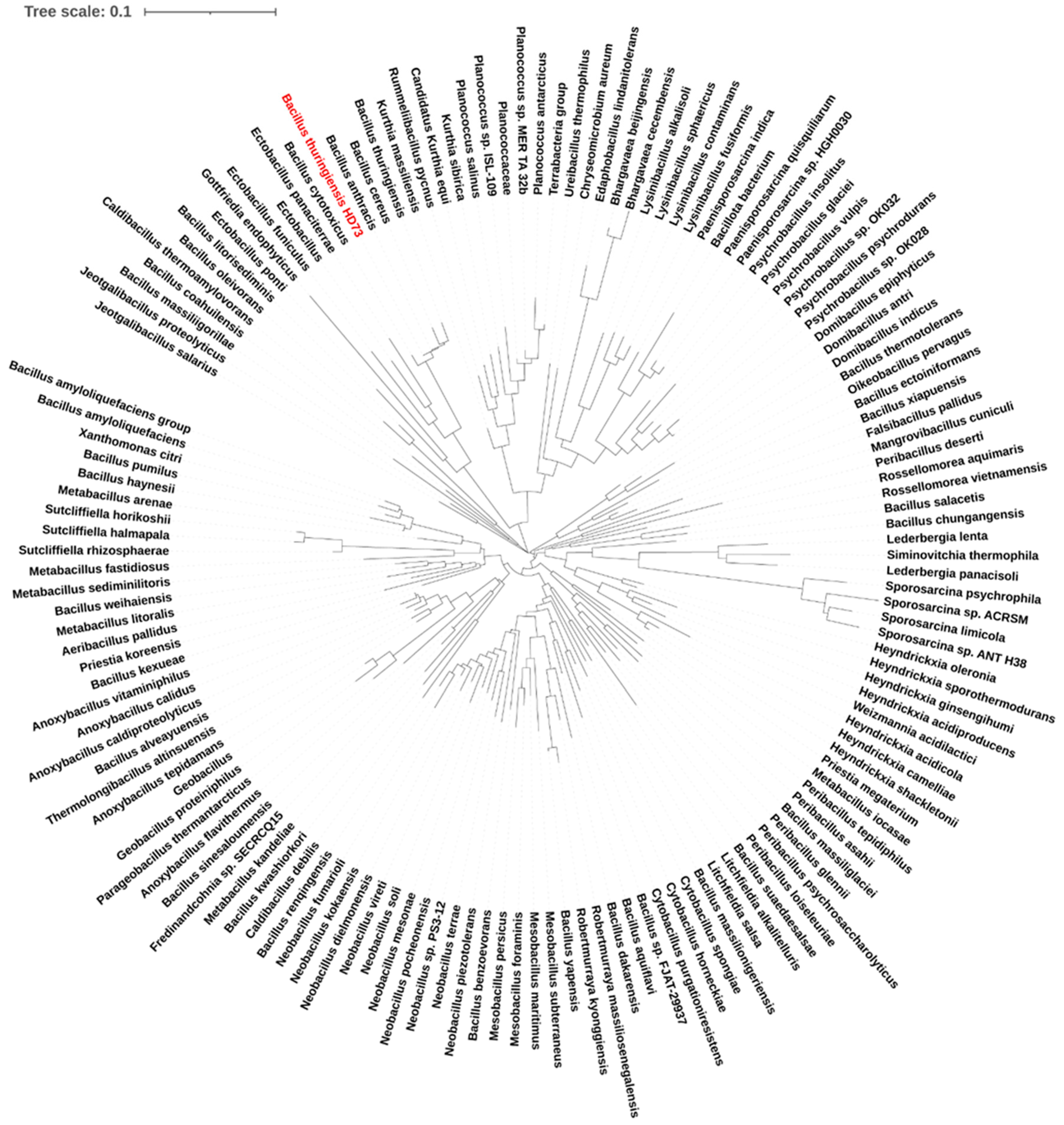
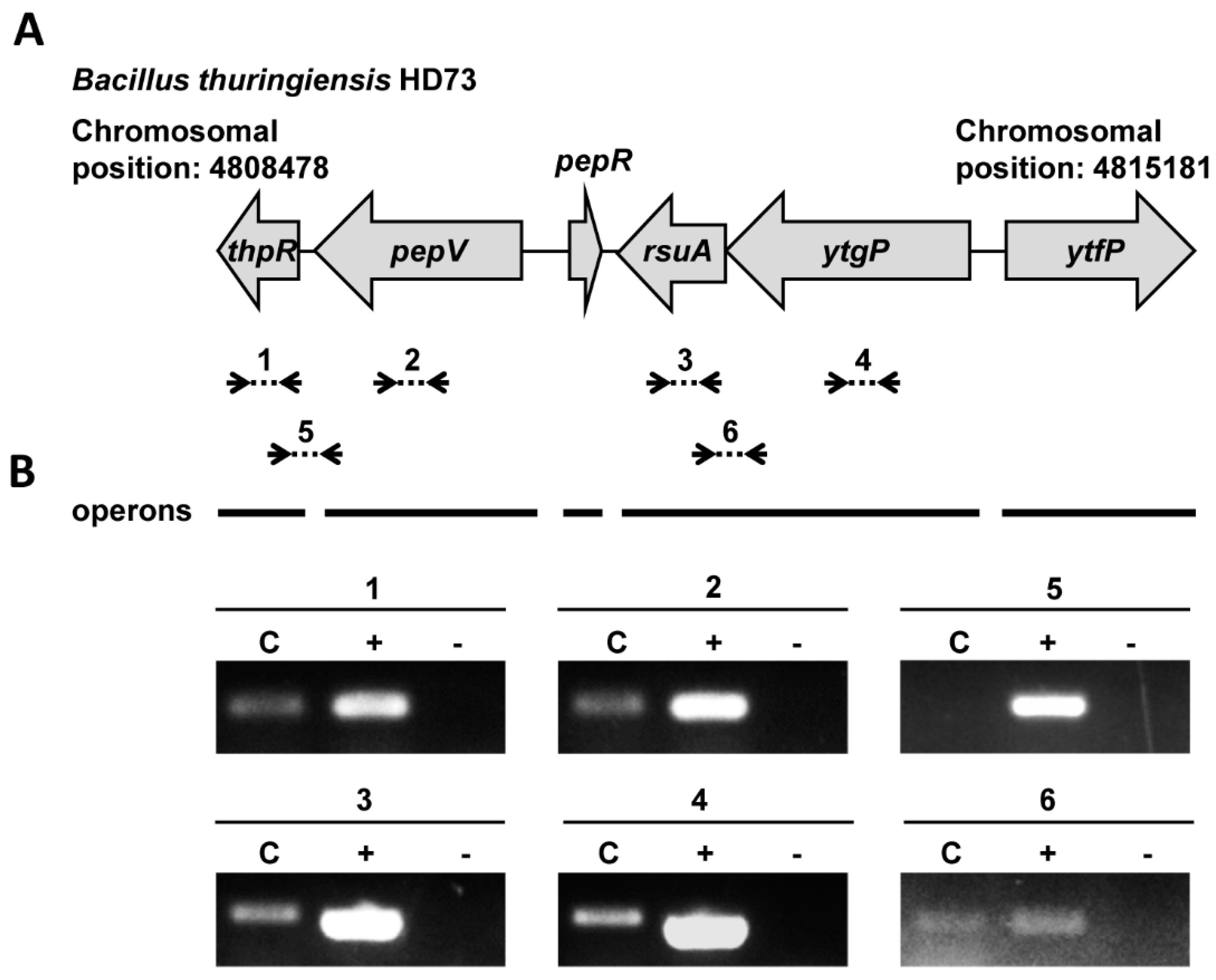
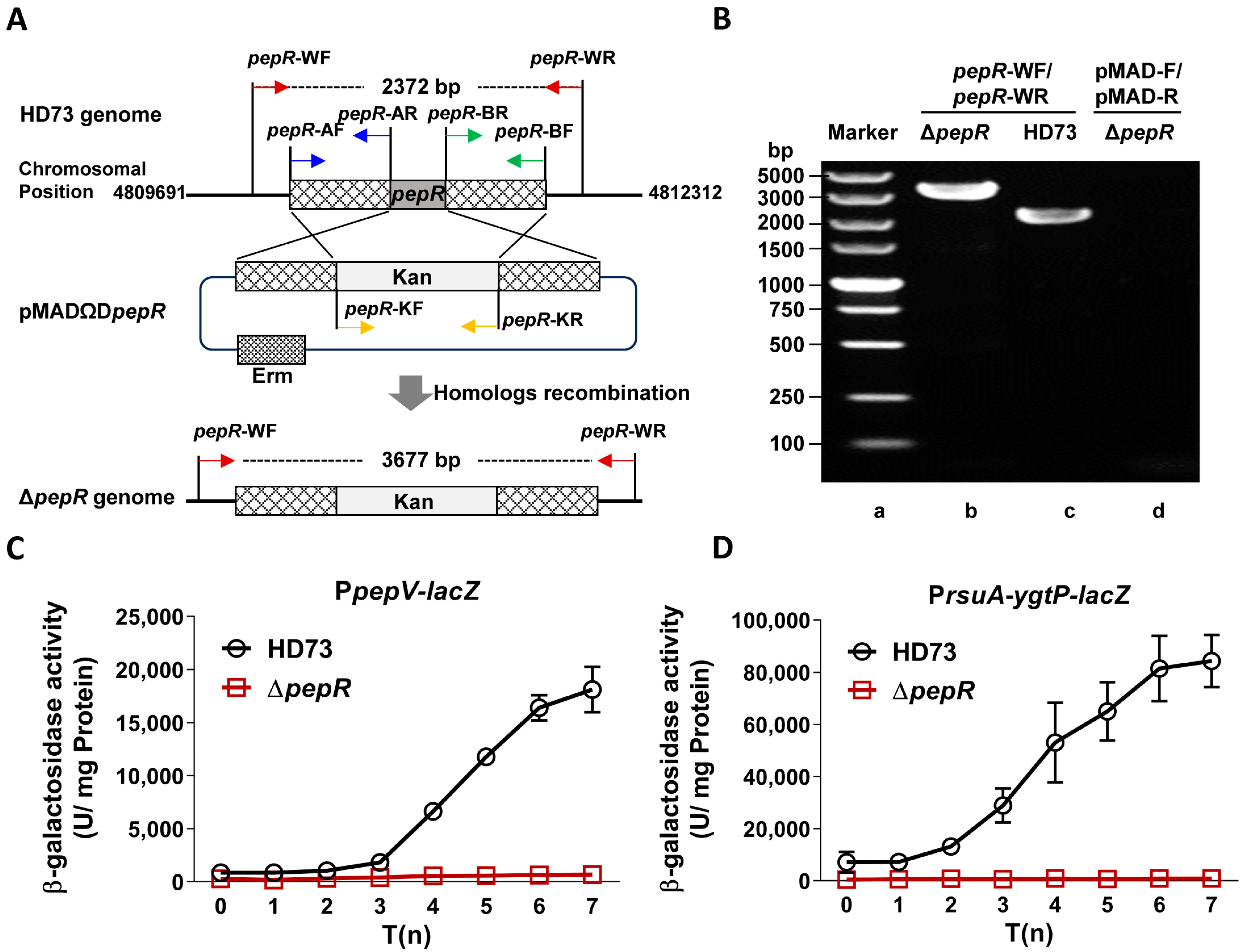

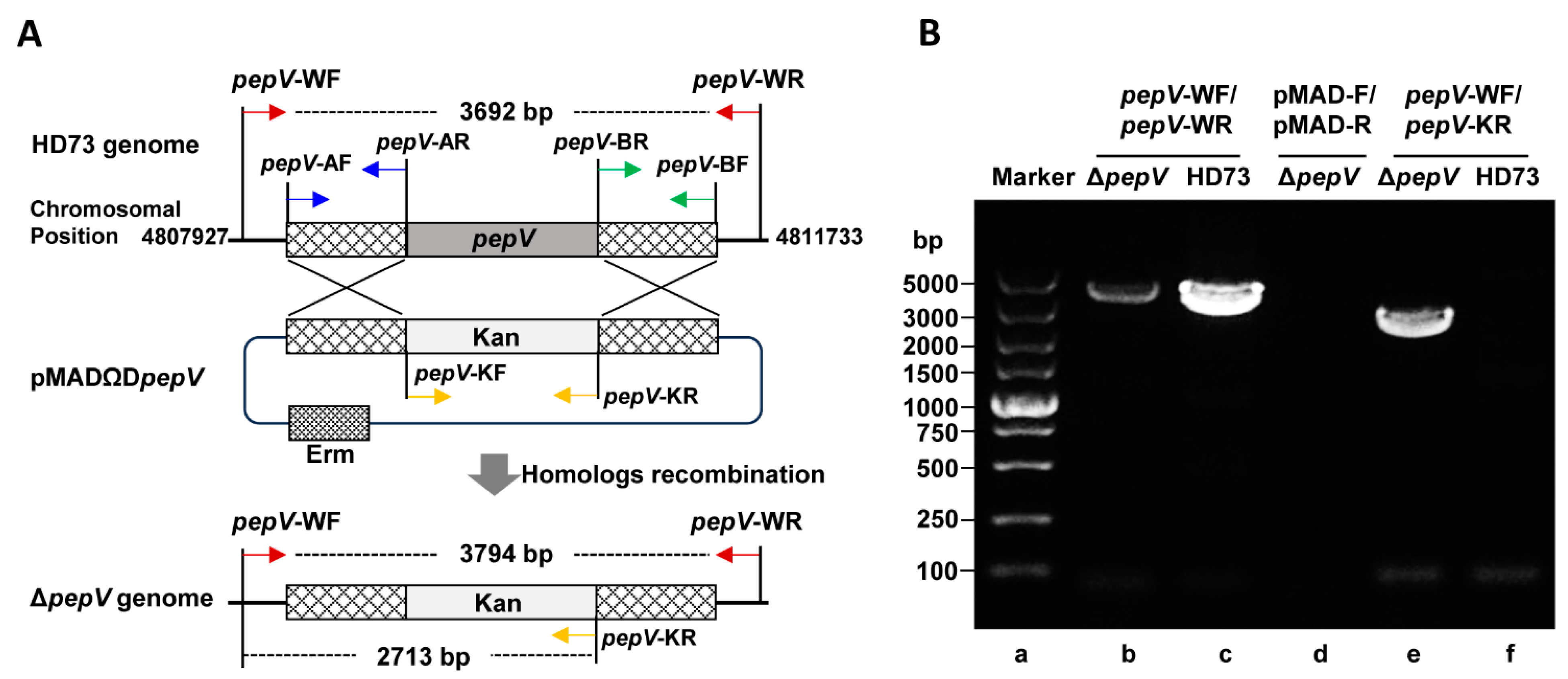
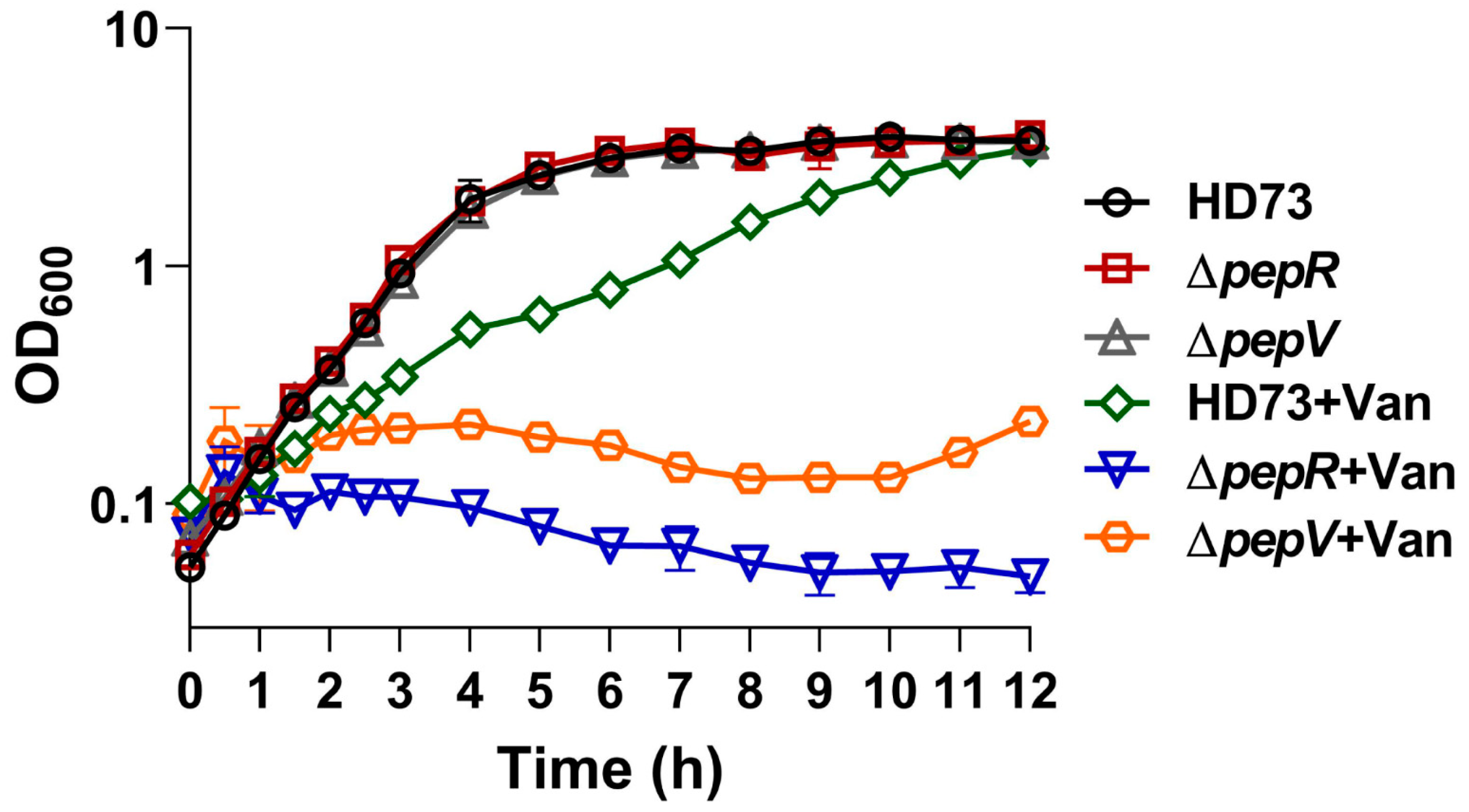
| Strain or Plasmid | Relevant Details a | Reference or Source |
|---|---|---|
| E. coli strains | ||
| E. coli TG1 | ∆(lac-proAB) supE thi hsd-5 (F′ traD36 proA+ proB+ lacIq lacZ∆M15), general purpose cloning host | Laboratory collection |
| E. coli ET 12567 | F− dam-13::Tn 9 dcm-6 hsdM hsdR recF143 zjj-202::Tn10 galK2 galT22 ara14 pacY1 xyl-5 leuB6 thi-1, for generation of unmethylated DNA | Laboratory collection |
| BL21 (DE3) | F− dcmopmT hsds (rB− mB−) galλ(DE3) | [21] |
| BL21 (pETpepR) | BL21(DE3) with pETpepR plasmid | This study |
| B. thuringiensis strains | ||
| HD73 | Wild-type strain containing plasmid pHT73 carrying cry1Ac gene | Laboratory collection |
| ∆pepR | HD73 mutant, pepR gene was deleted by homologs recombination | This study |
| ∆pepV | HD73 mutant, pepV gene was deleted by homologs recombination | This study |
| HD (PpepV) | HD73 strain containing plasmid pHT304-PpepV-18Z | This study |
| ∆pepR (PpepV) | pepR mutant containing plasmid pHT304-PpepV-18Z | This study |
| HD (PrsuA-ytgP) | HD73 strain containing plasmid pHT304- PrsuA-ytgP-18Z | This study |
| ∆pepR (PrsuA-ytgP) | pepR mutant containing plasmid pHT304- PrsuA-ytgP-18Z | This study |
| Plasmids | ||
| pHT304-18Z | E. coli-Bt shuttle vector with promoter-less lacZ reporter, AmpR, ErmR | [22] |
| pET-21b | Expression vector; Ampr 5.4 kb | Laboratory collection |
| pMAD | AmpR, ErmR, temperature-sensitive E. coli-B. thuringiensis shuttle vector | [23] |
| pMADΩDspo0A | pMAD with spo0A deletion fragment, AmpR, ErmR, KanR | [24] |
| pMADΩDpepR | pMAD with pepR deletion fragment, AmpR, ErmR, KanR | This study |
| pMADΩDpepV | pMAD with pepV deletion fragment, AmpR, ErmR, KanR | This study |
| pETpepR | pET-21b containing pepR gene; Ampr | This study |
| 304PpepV | pHT304-18Z carrying PpepV, AmpR, ErmR | This study |
| 304PrsuA-ytgP | pHT304-18Z carrying PrsuA-ytgP, AmpR, ErmR | This study |
| Primer Name | Sequence (5′–3′) a | Restriction Site |
|---|---|---|
| pETpepR-F | CGGGATCCGTTGAAACCTACAACTACTCG | BamHI |
| pETpepR-R | ACGCGTCGACTGAGGTCATTCTCACTTTC | SalI |
| pepV-AF | GTACCCGGGAGCTCGAATTCCGAAATGTCCGACTTGTTCCATACG | EcoRI |
| pepV-AR | TCACCTCAAATGGTTCGCTGGAATTAGCGAAGTAATGGATATATAAATAATGTCCGCTC | |
| pepV-KF | GAGCGGACATTATTTATATATCCATTACTTCGCTAATTCCAGCGAACCATTTGAGGTGA | |
| pepV-KR | GAAGGATGGATGCGTGATGTCAGCAATTAATTGGAAATTCCTCGTAGGCGCTCG | |
| pepV-BF | CGAGCGCCTACGAGGAATTTCCAATTAATTGCTGACATCACGCATCCATCCTTC | |
| pepV-BR | CGTCGGGCGATATCGGATCCGCACACGTTGCAGGAGTAGTAACAGAAG | BamHI |
| pepV-WF | GATACACAGCACCTAAATCTGTACCTTCG | |
| pepV-WR | CCCAGTTGGACGACTTGATATCGATACGGAAGG | |
| pepR-AF | GTACCCGGGAGCTCGAATTCAATCAAATGAAACAAGTTCAT | EcoRI |
| pepR-AR | TCAAATGGTTCGCTGAATGCGTGTTAGCATACGAG | |
| pepR-KF | ATGCTAACACGCATTCAGCGAACCATTTGAGGTGA | |
| pepR-KR | TTATGAGGTCATTCTAAATTCCTCGTAGGCGCTCG | |
| pepR-BF | GCCTACGAGGAATTTAGAATGACCTCATAATGAAA | |
| pepR-BR | CGTCGGGCGATATCGGATCCCAATTTGTGCAGGTATTGGC | BamHI |
| pepR-WF | CTTCTCCTGTAATAACCGCTTCTGC | |
| pepR-WR | CTAACACTTATAATGGTCGTTGCTG | |
| pMAD-F | CCAAATTTCCTCTGGCCATT | |
| pMAD-R | CCTATACCTTGTCTGCCTCC | |
| PpepV-F | CGCGGATCCCATCACGCATCCATCCTTCACT | BamHI |
| PpepV-R | AACTGCAGGAGAAAACCACTCCTCTAC | PstI |
| PrsuA-ytgP-F | AACTGCAGCTGCAGCACCAATTGCAGCCATTAG | PstI |
| PrsuA-ytgP-R | CGCGGATCCGTAACAATAAGCGTTCCGCGCAG | BamHI |
| RT-thpR-F | ACGAGCAACGGTAATA | |
| RT-thpR-R | GGGCGAAGGTAAGTGA | |
| RT-pepV-F | TGATGTGGGCGAGAAT | |
| RT-pepV-R | ACGGTGGTAACTTAGGG | |
| RT-thpR-pepV-F | GTACATCTTCTCCTTCTTTC | |
| RT-thpR-pepV-R | GGCCCGCTATTCCCTGG | |
| RT-rsuA-F | CATCCTCTTCTGTTACTACTCC | |
| RT-rsuA-R | CAGCGACGGAAGATGATAATC | |
| RT-ytgP-F | GCTCCTACTGTACCGAAATAACG | |
| RT-ytgP-R | GATTCAGATCCACTAGGTGGAC | |
| RT-rsuA-ytgP-F | GTTTTTCACCTTCTTTATTTATC | |
| RT-rsuA-ytgP-R | CATGATTTCGCCTGATGGCCG | |
| RT-16S-F | TCGCATTAGCTAGTTGGTGAG | |
| RT-16S-R | TCTTCCCTAACAACAGAGTTT |
Disclaimer/Publisher’s Note: The statements, opinions and data contained in all publications are solely those of the individual author(s) and contributor(s) and not of MDPI and/or the editor(s). MDPI and/or the editor(s) disclaim responsibility for any injury to people or property resulting from any ideas, methods, instructions or products referred to in the content. |
© 2024 by the authors. Licensee MDPI, Basel, Switzerland. This article is an open access article distributed under the terms and conditions of the Creative Commons Attribution (CC BY) license (https://creativecommons.org/licenses/by/4.0/).
Share and Cite
Zhang, X.; Wang, H.; Yan, T.; Chen, Y.; Peng, Q.; Song, F. A Novel Regulator PepR Regulates the Expression of Dipeptidase Gene pepV in Bacillus thuringiensis. Microorganisms 2024, 12, 579. https://doi.org/10.3390/microorganisms12030579
Zhang X, Wang H, Yan T, Chen Y, Peng Q, Song F. A Novel Regulator PepR Regulates the Expression of Dipeptidase Gene pepV in Bacillus thuringiensis. Microorganisms. 2024; 12(3):579. https://doi.org/10.3390/microorganisms12030579
Chicago/Turabian StyleZhang, Xin, Hengjie Wang, Tinglu Yan, Yuhan Chen, Qi Peng, and Fuping Song. 2024. "A Novel Regulator PepR Regulates the Expression of Dipeptidase Gene pepV in Bacillus thuringiensis" Microorganisms 12, no. 3: 579. https://doi.org/10.3390/microorganisms12030579
APA StyleZhang, X., Wang, H., Yan, T., Chen, Y., Peng, Q., & Song, F. (2024). A Novel Regulator PepR Regulates the Expression of Dipeptidase Gene pepV in Bacillus thuringiensis. Microorganisms, 12(3), 579. https://doi.org/10.3390/microorganisms12030579





